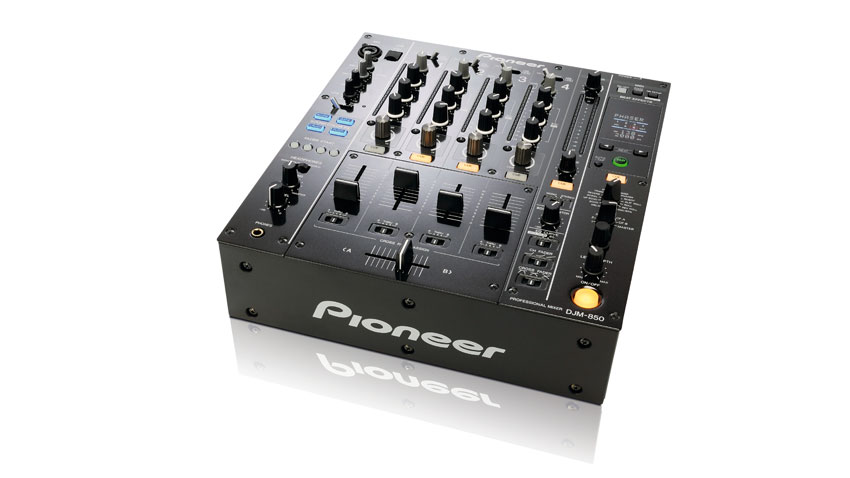MusicRadar Verdict
The DJM-850 is a top quality DJ mixer, updated with new effects and a USB sound card.
Pros
- +
Great DJ-friendly effects with attitude. High quality built-in USB sound card. Solid build quality.
Cons
- -
Not the cheapest DJ mixer.
MusicRadar's got your back

Pioneer DJM-850 Mixer

Rear panel
Pioneer DJ equipment didn't build its reputation on CDJs alone - its well-known mixers, such as the DJM-800, are also a staple in many DJ booths. So how does this new model improve on an already successful formula, and is it worth the upgrade?
"It shares the same build quality and styling that previous Pioneer mixers have become known for"
First impressions when removing the DJM-850 from its box are that it shares the same solid build quality and styling that previous Pioneer mixers have become known for. The unit weighs in at a reassuring 7.7kg, the case is metal and all of the buttons, knobs and faders feel firm and reliable. Controls are well spaced and the panel is clearly labelled, which is important for use in a dark club environment.
The layout will be familiar to owners of the DJM-800. In fact, the dimensions of the new unit are the same as the old one, which means that DJM-800 cases, rackmount kits and covers can also be used if you choose to upgrade. The three-band EQ can now be switched between normal mode (+6dB/-26dB) or the new full kill Isolator mode - very welcome for effective band kills. A significant new addition is the USB socket (sensibly located on the top of the mixer for easy access), which is used for the built-in audio interface and USB MIDI.
Sound quality is the same as its bigger brothers, the DJM-900 Nexus and DJM-2000. Pioneer have added a high quality 32-bit D/A convertor, kept audio paths as short as possible, and separated the digital and analogue circuitry. This results in a clear and punchy sound. One thing that's missing is digital inputs, but the analogue-to-digital convertors sound good, so perhaps it's no great loss. One of the main attractions of Pioneer mixers are the effects. These have been upgraded from the previous generation and come in two sections: instant gratification Colour effects, and time-based Beat effects.
Colour effects are applied independently to each mixer channel and include Noise (filtered white noise), Gate (a combination of gating and filtering), Crush (a bitcrusher/ downsampler) and Filter (high-pass or low-pass filtering). Only one Colour effect can be selected at a time, and as with previous Pioneer mixers, the Colour knob can be turned left for one variation of the effect and right for another - low-pass to the left and high-pass to the right being a classic example. These effects are well-chosen, quick to use, and have just the right kind of attitude for DJ use.
An exclusive new feature of the DJM-850 is the Beat button on each channel. This makes the volume of the sound control an aspect of the Colour effect. For example, the Noise effect pumps in sympathy with the beat, which sounds similar to sidechain compression. The Gate effect really comes alive when the Beat button is activated, with a short metallic delay being added to the sound.
Block rockin' beat effects
As with the 800, the main Beat effects section is where BPM synchronised effects are found. They work as post-fader send effects and can be assigned to a channel, one side of the crossfader, or the master output. The current tempo is either automatically detected, or set manually using a tap tempo button. There's a choice of 13 new and improved algorithms, plus an external send and return option.
Want all the hottest music and gear news, reviews, deals, features and more, direct to your inbox? Sign up here.
"Up Echo is a brand new effect for the 850 that combines pitchshifting and delay"
Effects on offer are similar to those in other recent Pioneer mixers, with old favourites such as Echo, Reverb and Flanger making a return. Two new types inherited from changed. Finally, Up Echo is a brand new effect for the 850 that combines pitchshifting and delay. With these new algorithms you can use the effect level knob for extra control. For example, with the Up Echo it controls the feedback and pitchshifting, as well as the usual wet and dry balance. Combining the Colour and Beat effects is a great way to add some spice to a DJ mix.
One change that some users have complained about is how the updated Echo effect is implemented. On the old model it would only start sampling into the Echo when it was turned on, allowing a single word or phrase to be echoed cleanly. The new version is always sampling into the Echo, which means that audio from before the desired sound will also be included. A workaround for this is to switch to the more expensive DJM-900 and 2000 are Spiral, which is a tape delay, and Slip Roll, which repeats a section of audio that is re-sampled whenever the effect time is Echo effect just before applying it. Unfortunately, this requires an extra hand for many common uses.
Perfect mix?
So what's missing? More expensive models have extra effects controls, digital inputs and Rekordbox/Pro DJ Link integration, but none of these are essentials. Owners of older mixers will be tempted to upgrade by the USB sound card, updated effects, and improved sound quality. Traktor Scratch timecode support is also handy.
At £1,299 this isn't the cheapest mixer, but for bars and smaller clubs, or serious DJs, the features, styling and solid build quality is hard to beat.